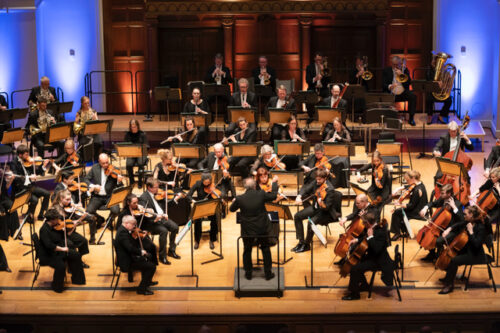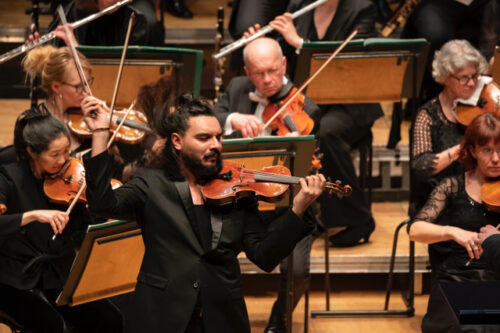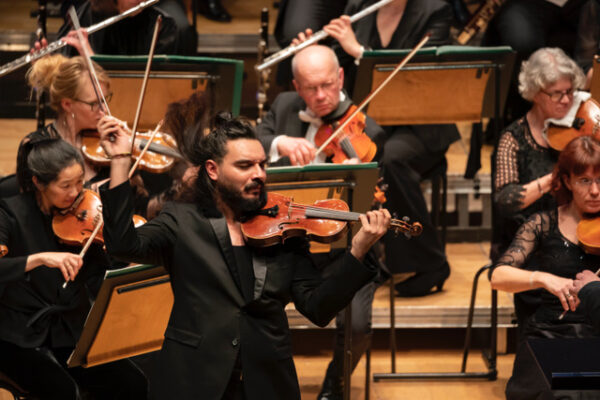 United Kingdom Grieg, Khachaturian, Sibelius: Nemanja Radulović (violin), Swedish Philharmonia / Jaime Martín (conductor). Cadogan Hall, London, 24.3.2023. (MBr)
United Kingdom Grieg, Khachaturian, Sibelius: Nemanja Radulović (violin), Swedish Philharmonia / Jaime Martín (conductor). Cadogan Hall, London, 24.3.2023. (MBr)

Grieg – Peer Gynt, Suite No.1
Khachaturian – Violin Concerto
Sibelius – Symphony No.2
Cadogan Hall is fast becoming one of my favourite places for concerts in London. Tucked away in Sloane Square, at the bottom end of the King’s Road, considerably more fashionable now than when I used to hang out on it as a barely legal teenager in the 1980s, it is like a pocket-sized Musikverein – but without the golden, statuesque beauty of it.
Pocket-sized tend to be the orchestras, too. The platform is considerably smaller than a standard concert hall one so most symphony orchestras which appear here – and it is one of the London bases of the Royal Philharmonic Orchestra – tend to play with reduced instrument numbers. With this particular concert, given by the visiting century-old Swedish Philharmonia, or Gävle Symphony Orchestra as they are also known as in Sweden, I had wondered whether the work in the second half, Sibelius’ Symphony No.2 would work; it did, and rather wonderfully as it happens.
Composers from Norway, Russia and Finland were on the program, conducted by Jaime Martín. I am certain I have not heard Grieg’s Peer Gynt since childhood. However, this exhilarating performance did remind me what a consistently beautiful piece it is – at least as seen through the prism of the Suite No.1. The Suite appeared in 1888, the same year that Rimsky-Korsakov wrote Scheherazade, and both composers looked to the Orient for their inspiration, even if Grieg’s music doesn’t necessarily have the colour that Rimsky-Korsakov so lavishly applied to his work. Anitra’s Dance is supposedly Arabian in Grieg’s Peer Gynt, but barely acknowledged through the music in this way; the Young Prince and the Princess from Scheherazade is entirely the opposite. Both composers, incidentally, use almost exactly the same instrumentation (no harps in Grieg, however).
Morning Mood’s North African sunrise set the template for how Martín would use his orchestra. The sonority was beautiful – rich, yet supple, strings but with great tonal warmth. Some orchestras can sound contrived as they shift dynamics – here the swells were so natural, and seamless. Brass were well-balanced. For both The Death of Åse and Anitra’s Dance – both only scored for strings – Grieg’s lighter orchestration often seemed illusory. Best of all was an electrifying In the Hall of the Mountain King played with pin-point virtuosity and the kind of thrilling tempi only orchestras extremely familiar with this music could ever manage.
The second work – something of a concert rarity these days – was Aram Khachaturian’s Violin Concerto. Written for David Oistrakh in 1940, it’s Tchaikovskian influences lend it a virtuoso flair – and it is certainly very heavy on notes for the soloist. There is no shortage of great Russian performances – elsewhere we are on shaky ground. There are at least two Oistrakh recordings, both with Khachaturian (Philharmonia/EMI, 1954 and USSR SO/Russian Disc, August 1965). Leonid Kogan has two recordings, too (Grand SO, Khachaturian/Russian Disc, 1951 and Boston SO/Monteux, 1959). Finally, Julian Sitkovetsky (Romanian Radio Orch, Niyaz/Russian Disc, 1954).

Non-Russian performances have tended to struggle with the piece, not because of the work’s virtuosity, but because of the heavy influences in its writing to the music of Khachaturian’s Caucasian background, folk-inspired themes and a sense of national nativity and solidarity. One violinist who has made a successful recording of the concerto is the Serbian-French player, Nemanja Radulović, the soloist for this concert performance.
His style of playing, certainly an openness of interpretation, and a charismatic stage presence, is partially reminiscent of a great Hungarian violinist I saw at Ronnie Scott’s many years ago, Roby Lakatos. In silhouette, it wouldn’t be difficult to create the image of Radulović as Paganini from the drawings we know of that violinist, either. He is, however, both too careful and too shrewd to deliberately give the illusion he is anything other than Nemanja Radulović: the virtuosity, the sound, the colour palette, and the distinctive idiomatic blending is very much unique to him.
This was unquestionably a fiery performance in the outer movements, blazing in fact. But it was also a considerable achievement from a narrational point of view. The ‘nationalistic’ character of the work almost demands the soloist becomes the central orator in this vast dramatic concerto. The central movement, an Andante sostenuto, has been described as a lament; however, it can be rather more than that. Radulović took the chromatic inflections of the movement with extraordinary intensity – this was less a lament, more a soliloquy from an Aeschylean tragedy. This was considerably more gripping than any account of this movement I have previously heard live – the two explosive, fortissimo passages arriving like the Kraken through the ocean, the final pianissimo an unresolved retreat of devastation and bleakness.
If Radulović had showed tenacity in the first movement – there is barely room for the soloist to breathe after the cadenza, with just three, short, bars of rest – the Allegro vivace was a tour de force. Relentless, and yet sometimes dark and brooding, even perhaps a little reminiscent of Sibelius, the music catapults notes out with almost merciless speed. When it came, the end was thrilling, soloist and orchestra, as they had done at the end of the first movement, ending together on a knife-edge. Ironically, Radulović’s encore did indeed find him in Lakatos territory with a traditional Serbian dance. Pašona Kolo, a kaleidoscopic gallop of trills and arpeggios and finger work of dizzying speed, was thrilling. The strings of the Swedish Philharmonia were extraordinarily clean – and clearly having fun. Two minutes of sheer delight.
As lean as Sibelius’ Second Symphony is, compared to the First, this performance by the Swedish Philharmonia would be leaner still. However, it is very much the quality of the cut you get – not the thickness of it – and that so proved to be the case here.
Again, it was the sheer glow of the strings that mattered here – how beautifully they ebbed through the opening bars, like shallow waves, with the most subtle rolling of the notes against the bar lines. So etched in subtlety was the playing, that some of this symphony’s more programmatic music – in the Andante, ma rubato, for example – had the feeling of CinemaScope to it, of dramatic horror and death, and music inflected by disease and suicide: this is, after all, the music of Dante and his Divine Comedy and Don Juan. But it is Sibelius’ own personal tragedy and here it often felt like each player’s own, too, so intense became the playing.
If the string bowing had always been resonant, the pizzicato playing was extraordinarily vivid. It could be hollow, like the sudden striking of a tornado and its echoing tailwind rattling the bones of a stripped back chest cavity. Or, just like the echo of footsteps. The final movement, glowing and handsomely burnished in the brass, was magnificently noble – but perhaps just ambiguous enough. Was this Sibelius’ own personal journey, from tragedy and struggle, through to a new beginning? Or was it a performance tinged with nationalist notions? Perhaps in a performance as magnetic as this one it just didn’t matter.
A memorable concert.
Marc Bridle
